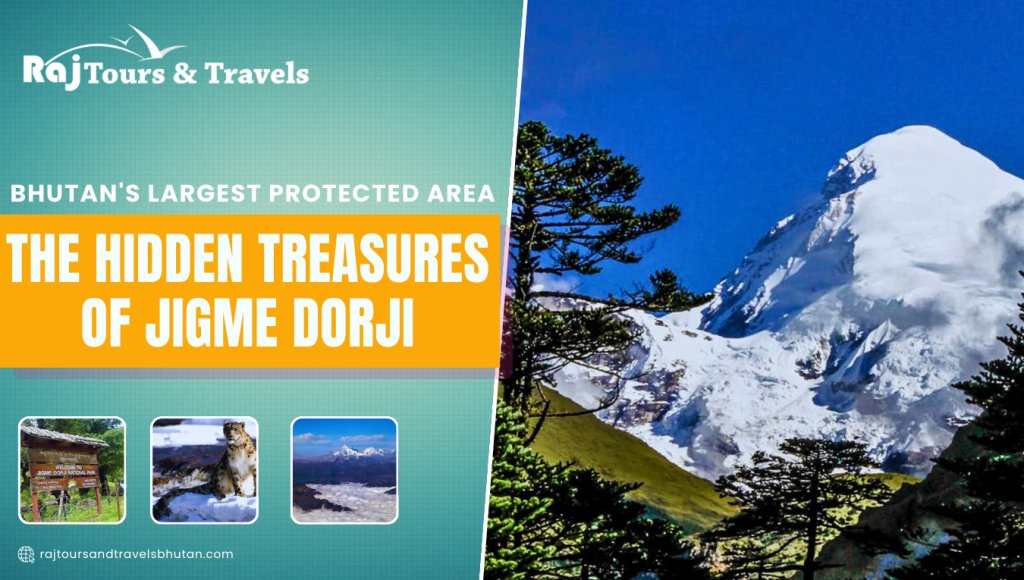Jigme Dorji National Park, spanning over 4,300 square kilometers, is Bhutan’s largest protected area and a haven for biodiversity. This expansive park, located in the northwest region of Bhutan, is named after the third king of Bhutan, Jigme Dorji Wangchuck. It is a sanctuary that preserves the country’s rich natural heritage, offering a pristine environment where wildlife thrives and nature remains untouched. For adventurers and nature enthusiasts, Jigme Dorji National Park promises a journey into the heart of Bhutan’s wilderness, where every trail leads to a new discovery.
The Rich Biodiversity of Jigme Dorji National Park
Jigme Dorji National Park is renowned for its incredible biodiversity. The park is home to some of Bhutan’s most iconic and rare wildlife species, including the elusive snow leopard, the Bengal tiger, and the Himalayan blue sheep. Bird watchers will be thrilled by the variety of avian species, such as the majestic black-necked crane and the vibrant Himalayan monal. The park’s diverse ecosystems, ranging from lush subtropical forests to alpine meadows, support an array of plant species, including medicinal herbs and beautiful orchids. Each ecosystem within the park plays a crucial role in maintaining the ecological balance, making it a vital area for conservation efforts.
Key Attractions within the Park
Gasa Hot Springs
One of the hidden treasures within Jigme Dorji National Park is the Gasa Hot Springs. These natural hot springs are renowned for their therapeutic properties, attracting both locals and tourists seeking relaxation and healing. Surrounded by stunning landscapes, the hot springs offer a perfect spot to unwind after a day of exploring the park. The warm, mineral-rich waters are believed to alleviate various ailments, making them a popular destination for wellness seekers.
Lingshi Dzong
Another significant attraction is the Lingshi Dzong, an ancient fortress that stands as a testament to Bhutan’s rich cultural history. Located at an altitude of over 4,000 meters, this dzong offers breathtaking views of the surrounding mountains and valleys. It serves as a reminder of Bhutan’s strategic importance in the past and its architectural prowess. Visitors to Lingshi Dzong can immerse themselves in Bhutanese history and culture while enjoying the serene beauty of the high-altitude landscape.
Best Activities to Enjoy in Jigme Dorji National Park
For adventure seekers, Jigme Dorji National Park is a paradise of outdoor activities. Hiking and trekking are among the most popular pursuits, with trails that cater to various levels of experience. The Snowman Trek, one of the most challenging and rewarding treks in Bhutan, takes you through the park’s rugged terrain, offering spectacular views and a chance to encounter rare wildlife. Bird watching is another favorite activity, with numerous opportunities to spot rare and beautiful bird species in their natural habitat. Additionally, camping under the starry skies, with the sounds of nature as your lullaby, provides an unforgettable experience for those looking to connect deeply with the wilderness.
Practical Tips for Visiting Jigme Dorji National Park
Best Time to Visit Jigme Dorji National Park
The best time to visit Jigme Dorji National Park is during the spring (March to May) and autumn (September to November) seasons. During these periods, the weather is mild, and the trails are most accessible. Spring brings blooming rhododendrons and vibrant flora, while autumn offers clear skies and stunning foliage, enhancing the natural beauty of the park.
What to Bring
When planning a trip to Jigme Dorji National Park, it’s essential to come well-prepared. Due to the varied altitude and weather conditions, pack layers of clothing to stay comfortable. Sturdy hiking boots are a must for navigating the park’s trails. Don’t forget to bring a good pair of binoculars for bird watching and a camera to capture the breathtaking scenery. Additionally, pack enough food and water for your excursions, as amenities within the park are limited. Lastly, respect the local customs and wildlife, ensuring that your visit has minimal impact on the environment.

